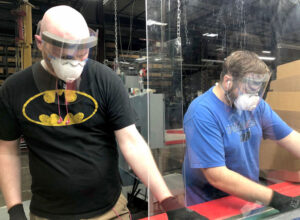By Hallie Forcinio, contributing writer, PostPress
Whether reopening, working at reduced capacity or running full out as the COVID-19 pandemic continues, businesses are striving to make work environments safer for personnel and customers and to maintain positive cash flow.
During a webinar on April 22, 2020, “Working Through COVID-19,” executives from MCD, Inc.; BrightMARKS LLC; SunDance; and Datagraphic + Spectragraphic described how their print finishing and printing businesses have been affected by the pandemic and how they are preparing for the future.
Sales have plummeted, but many projects have been put on hold rather than canceled. JohnHenry Ruggieri, managing director of SunDance, an Orlando, Florida-based full-service printer and finisher, which serves many tourist-related businesses, believes most jobs now on hold will go forward eventually. Sean Hurley, vice president of Sales at MCD in Madison, Wisconsin, a full-service print finishing operation, also feels optimistic. Despite a 50% slide in sales in April 2020 and a similar downturn expected for May, he said, “We feel sales will come back in June and get better after that as confidence builds.”
Located on Long Island in Commack, New York, Datagraphic + Spectragraphic, offering commercial printing and finishing solutions, has been shut down as a non-essential business but was hoping to reopen in mid-May to supply customers that are classified as essential. “Everything has come to a grinding halt,” reported Glenn Schuster, president of Datagraphic + Spectragraphic. Meanwhile, the company has been operating on a limited basis to produce face shields to protect healthcare workers and first responders. A customer that is assembling the face shields knew Datagraphic + Spectragraphic works with plastics and asked for help.
“Within the hour, we were testing the material,” recalled Schuster. “We quickly learned that we needed a special knife called a Viking blade, which is extra hard and sharp, to cut through the 30-mil Lexan [polycarbonate sheet],” he explained. Once that challenge was solved, it simply was a matter of adjusting the knife cutting height on the press. “We’ve stamped out close to 200,000 shields,” said Schuster, noting it is a way to give back. He added, “It’s been a feel-good type of project. That’s the silver lining if there is one in all of this.”
David Hutchison, chief executive officer/managing member of BrightMARKS in Lenexa, Kansas, which offers print finishing and decorating services, reported the company’s direct mail business is down about 50% and, “There is virtually no activity at the moment in greeting cards and social stationery.” Fortunately, he said, “Our packaging business is not off as much.” With packaging serving essential business categories, “We are seeing volume come in there,” he explained.
In direct mail, he noted, “Customers are starting to realize people who are quarantined are excited to get mail. We are quoting some very large projects that will go as soon as the retail environment opens up. We are hopeful that will come about in late June or mid-July.”
Schuster agreed on the trajectory for direct mail and predicted it will bounce back quicker than some other segments. “When the switch is turned back on, people are going to need to communicate with their customers,” he explained.
The outlook for greeting cards also looks positive. Webinar Moderator Jeff Peterson, FSEA executive director and editor-in-chief of PostPress, noted people who won’t be attending spring/summer gatherings like weddings and graduations in person still will send a card. “If people are unable to attend gatherings, such as graduations and weddings, they are more likely to choose a more expensive, foil and embossed card to mail,” stated Peterson.
Staying safe

Every business – whether open, partially open or preparing to open – is implementing changes to keep personnel safe in the plant and office. Common practices include employee education about the risks associated with the virus and the steps being taken to maximize employee safety, working from home if possible – particularly for more vulnerable employees, temperature checks at the start of each shift, enhanced cleaning regimens and maintaining social distancing by closing common areas, installing barriers and staggering shifts. Visitors, if allowed at all, are required to wear a mask and perhaps gloves.
Ruggieri of Sundance reported, “The first thing we did was to implement a quick and effective method of delivering information to all employees, because a lot of employees didn’t have company email.” The next step was reducing the population in the building. He explained, “People who can work from home do so, and the rest work either a Monday/Wednesday/Friday shift or a Tuesday/Thursday/Saturday shift. The headcount in the building is about one-third at any one time.”
At BrightMARKS, operators wipe down equipment at the beginning and end of each shift, and other cleaning and sanitation tasks are done more often. In addition, every Sunday the offices and production facility are treated by Jan-Pro with the EnviroShield system, a disinfectant mist that eliminates more than 99.99% of bacteria and viruses.
Practices vary somewhat to meet state requirements. In Pennsylvania, where a face covering must be worn when entering any place of business, Menasha Packaging Company, a folding carton manufacturer based in York, Pennsylvania, provided employees with cloth masks or bandanas with instructions on how to wear and launder their masks.
“We did not mandate they wear the supplied masks as long as they had the required face covering, so we have a variety of face coverings,” explained Perry Whittaker, graphic finishing area manager at the York facility, who was an attendee of the “Working Through COVID-19” webinar audience. The company also instituted a temperature check for all associates entering the building. He stated, “This was very well received, and the associates are more at ease since we started doing this.” In addition to sanitizing machines twice each shift, he said, “We also have an extra crew cleaning all common areas throughout the day.”
Supply chain challenges
As of April 22, 2020, the day the webinar was recorded, supply chain disruptions were minimal. The only item in short supply was wide-format plastics. “All the extruders are doing clear material for face shields,” explained Hurley of MCD.
“We’ve been fortunate,” said Ruggieri. “We had some delays in flexo dies and label stock but now have a 60-day supply.”
Schuster added, “We’ve been in touch with our suppliers. They have been helpful in extending terms and will be ready to supply us with whatever we need to print.” Maintaining contact with suppliers will be especially important as projects currently on hold receive green lights. As demand ramps up, supplies are likely to tighten, so it is important to plan ahead and place orders as soon as possible.
Meanwhile, Hutchison stresses the importance of communication from suppliers. “We heard from a few, but I expected to hear from a number of others,” he said.
Customer contact
Keeping in touch with customers is equally important even if no projects are active. “It’s a sensitive time right now to ask for business, but it’s okay to let your customer know you’ll be ready when they need you,” said Schuster, explaining that Datagraphic + Spectragraphic has been sending e-blasts. He noted, “The face shield effort was a good [e-blast] message to send. It actually pushed traffic to the GoFundMe page of the vendor assembling the shields.”
Hurley advocates being proactive and is using Constant Contact or Zoom to stay in touch with customers. “It’s a good time for old-school relationship building,” added Hutchison. He explained, “People want to talk about more than a specific estimate, job or project detail. We are finding it a good opportunity to learn more about our customers. We’re surveying 100% of our customers to see who is operational and letting them know we can support them as needed.”
Maintaining positive cash flow
With drastically diminished sales, cash flow can turn negative, and it becomes difficult to pay vendors and meet payroll. To prevent layoffs and help preserve positive cash flow, the four firms represented on the webinar panel promptly applied for a Payroll Protection Program (PPP) loan and have received funds.
Hutchison said, even if the slowdown gets worse before it gets better, the PPP, “gives us the opportunity to retain all of our people.” Schuster agrees the PPP is a godsend but is concerned its eight-week timeframe could expire prematurely if the company is not able to resume full operation soon.
All four firms are encountering slower collection of trade receivables. Collection tactics include extending terms, negotiating a payment schedule or forgiving a portion of the bill. “Each case should be handled on its own merit,” recommended Hutchison. “Goodwill is important,” concluded Hurley.





